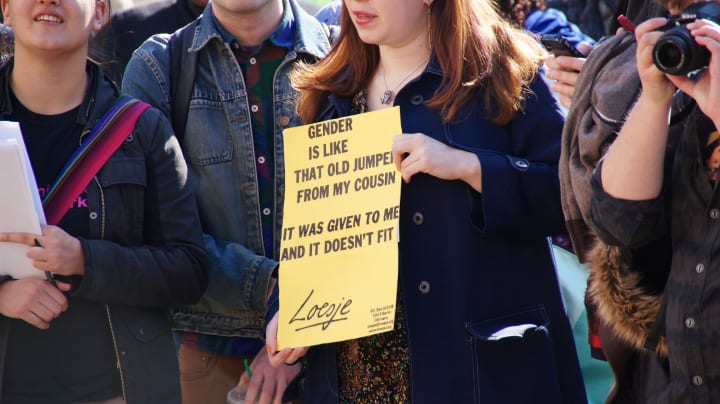Nonbinary: What Is It and Why Is It Suddenly So Popular?
(And Why You Should Care)

Lots of people these days, it seems, identify as "nonbinary." But what is a nonbinary gender? Where do it come from? Why is it suddenly so much more popular than it was ten years ago?
Definitions

People who identify with the binary gender they were assigned at birth are called "cisgender," or "cis."
Commonly, nonbinary individuals use "they/them" pronouns, although they may also use others (she/her, he/him, xe/xir, etc). It's possible to use different pronouns interchangeably, or to change set pronouns overtime.
People under this umbrella might identify as LGBT, or they might not (in my experience, they usually do).
Don't know someone's pronouns? Just ask! It's what you do if you meet someone's pet for the first time, isn't it? Why not do it for people, too?
Online Communities

Recently, California became the first state to legitimize a "third gender" option for official documents. Celebrities like Angel Haze, Amandla Stenberg and Ruby Rose have all recently come out as either nonbinary, genderfluid, or gender-nonconforming.
So why has this strange new concept suddenly gained so much traction? Is it the newest liberal fad?
LGBT identities have always existed, and likewise always will. But only recently have widespread, easily accessible communities and safe places for discourse came about. The source? The thing we all love, hate, and can't live without: the Internet.
According to Internet World Stats, Internet use has skyrocketed from 16 million people in 1995 to 3,385 million people in 2017 (less than one percent of people to a whopping 57 percent of people!). The world wide web has become much more accessible, mainstream, and user-friendly over the few years since its inception.
It's no secret that the LGBT have been (and still are) brutally targeted by prejudice and hate crime, making it sometimes difficult to have any meaningful public discourse about the community without serious risk of personal harm. Since the Stonewall riots of 60s and 70s, public places have become a bit safer for anyone outside of the heterosexual, cisgender population; but it's still dangerous. The Pulse shooting in Orlando, various extreme hate crimes since Trump's election, and stories like this one (warning: extremely brutal and depressing) are proof enough that this is not a safe time to be part of the LGBT community.
So the Internet has become a godsend for all types of fringe communities, from atheists to furries, modern witches to genderqueer folks. The LGBT community now more than ever has a safe, accessible means to communicate ideas and experiences. Ideas and titles that before had no name now have one, and anyone can look them up and learn.
Isn't it Just a Fad?

Ancient same-sex romantic art.
As I've said, non-cis identities have always existed.
In Somoa, there are the Fa'afafine—people who are assigned male at birth, and typically have sex with other men or with women, but who identify as a third gender. The Fa'afafine are an integral part of Samoan society.
In India, there are the hijras—generally born "male," but identifying with neither binary gender. Many countries recognize hijra officially as a third gender, and these people play a crucial role within their communities (even though they are often shunned). Their existence dates back to ancient writings, where they were often praised.
There are the Kathoeys, a Thai gender composed of people identifying either as transgender, or a third gender. They are often sex workers or performers.
The Warias of Indonesia are composed of genderqueer and transgender individuals who identify with the term "Waria," and are gradually gaining more acceptance in the country.
There are also the two-spirit Native Americans, who identify with a gender entirely separate from the binary.
The Science of Sex and Gender

In America, we have a very genital-centric idea of gender. But gender does not equal sex, and sex does not equal gender. It never has. Just as race is a social construct and not based on biology (for example: people within the same "race" have more genetic variation than a people from two separate "races"). Simply put, how someone's gender is decided is based entirely on their culture's specific customs.
But not everyone identifies with the gender they are given. And that's okay. Until a few years ago, the DSM—or the standard document for diagnosing psychological conditions—considered transgender or homosexual identities and gender dysphoria as "paraphilias," or maladaptive sexual disorders. Luckily, we've moved on from that—but the stigma persists.
Intersex
If you asked most people, they'd tell you that there are 2 biological sexes: male and female. Males have testes, a penis, and XY chromosomes; females have ovaries, a vagina, and XX chromosomes.
But there are a lot of exceptions to this rule, and we know that sex isn't set in stone. X, XXY, XXXY, and XYY are all known to exist; people with ambiguous genitals, genitals that don't "match up" to their gonads, or other features that don't fit into the accepted male/female norm.
According to ISNA, about 1 in 100 births have children whose bodies don't fit the typical standard. Often, these babies—called intersex—are forced to "become" male or female by genital mutilation, corrective surgery, and the like.
So, male/female sexes may be the norm, but that doesn't mean that those outside of the norm are less real, or less valid.
Gender is not sex. Just as genetics isn't family, biological sex can influence gender, but it does not decide it. Gender is the personally-held (although often socially constructed) belief one has about their own body—masculine, feminine, neither, or something entirely different.
A cultures perception of gender shapes its meaning. Anything masculine is typically considered strong, bold, assertive, aggressive, proud, and demanding; anything feminine is considered soft, passive, nurturing, and weak. These attitudes dictate the roles that people are expected to play based on their assigned, or perceived, gender.
These roles aren't concrete among other cultures, peoples, or even animals. While most societies are patriarchal, many value women as equals; some matriarchs still remain, such as the Akan in Ghana. Some cultures dictate that women stay at home, raise children, and care for the house; others expect women to join the workforce; some expect women to take multiple husbands at a time, while others don't condone multiple partnerships.
Secondary sex characteristics such as build and facial hair seem to dictate gender in America, but other countries—where body builds are different—might have a totally different idea of what is masculine versus what is feminine.
Fitting people into the tight boxes of male vs female restrict's people's abilities to feel good about themselves, learn new skills, and pursue their interests. It's not right, it's not effective, and it has no place in 2018.
About the Creator
Felecia Burgett
Novice writer, amateur novelist, poet, article writer, dabble, and animal lover.






Comments
There are no comments for this story
Be the first to respond and start the conversation.